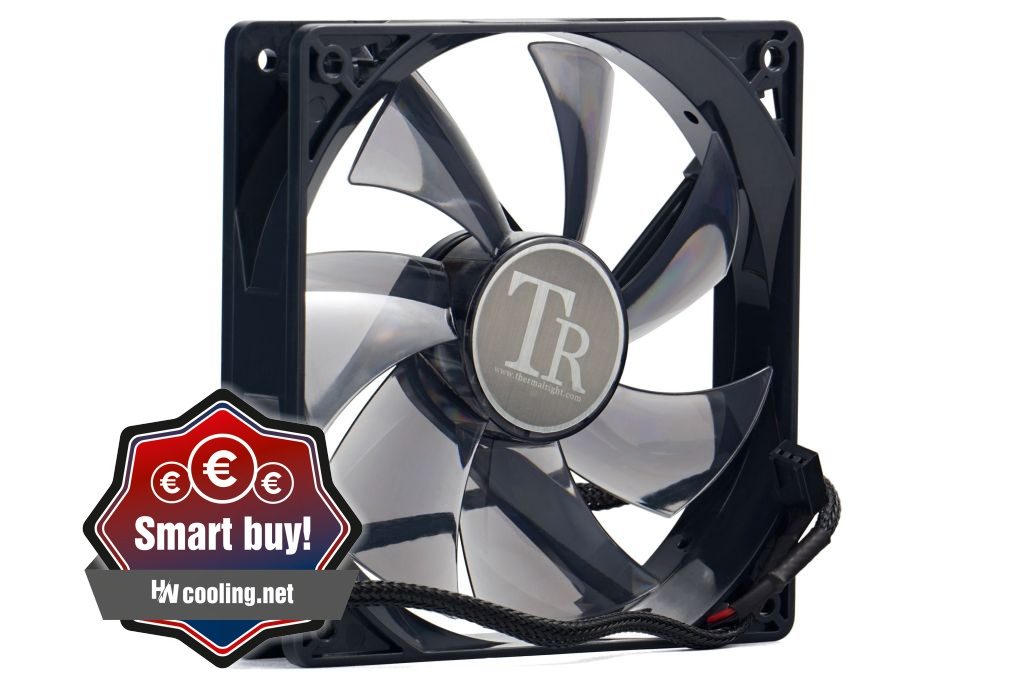Evaluation
Thermalright fans have been somewhat overshadowed by great heatsink throughout this company’s history. For a long time, even relatively high minimum speeds were awkward. These have now been tamed for most current models and the X-Silent 120 has a superbly low top speed as well. This is the “slowest” fan we have tested to date. With a price of under five euros, it also ranks among the cheapest you can buy.
Evaluation
Considering the price, the efficiency of the X-Silent 120 is excellent. In system positions (with filters, on a grille) It’s even on par with the ROG Strix XF120, which is five times more expensive. You can also comfortably install this Thermalright with a regular nylon filter, with which, from 400 rpm onwards, it beats the Noctua NF-P12 redux, for example. The X-Silent 120 can also be considered as a very cheap replacement for a damaged fan on a cooler heatsink. The results on the radiators are admittedly “only” average, but don’t forget that we’re still talking about a fan at the price of a better baguette.
For such cheap fans, it can be considered a success that they can be slowed down to our quietest test mode. Even more expensive fans have trouble with it because of their typically noisier motors. You can tune the X-Silent to virtually noiseless operation without the slightest difficulty, although the most demanding users won’t be able to escape minor parasitic noises from the motor and bearings. But these are such cosmetics that it’s almost silly to bring them up in this price range.
Anyway, the motor gently purrs and in the vertical position the microphone (and a bat’s ears) pick up even a faint rustling. Those are the elevations at higher frequencies with peaks around 5 and 10 kHz in the spectrograph. Next to the more intense aerodynamic noise they disappear, but at very low speeds they have some contribution to the overall noise level expressed in dBA. Most of the fans tested did not exhibit this or any similar sound. We point this out, however, mainly to try to make sure that you can read those spectral analyses as well as possible. The rustling only occurs vertically, it disappears in the horizontal position. This directly indicates bearing play and sound from the more intense mechanical friction that naturally occurs due to gravity.
The vibration of the X-Silent 120 is very low, which is a big advantage compared to the Arctic P12. Those fans, on the other hand, vibrate quite a bit.
In addition to the top-notch price/performance ratio (that is, assuming you buy the fan at a discounted price) the airflow per watt is also top-notch. The lower the speed, the more the X-Silent breaks away from other fans in this regard. Mostly so at speeds around 300 rpm. And know that even at these speeds, it achieves impressive airflow for system cooling while keeping noise levels extremely low. These fans can be particularly advantageous in PC builds designed for non-stop operation. However, the power of the motor is relatively low with respect to the maximum operating power draw. Thus, the lifespan in dirtier environments could be relatively short. Since the fan has no degree of protection, dust will sooner or later get inside (to the lubricant), thus increasing friction and at some point the motor will no longer move the rotor due to its lower power.
Shame about the restriction to linear regulation too. Before buying this fan, it’s a good idea to make sure your motherboard can handle fan control in the lower range below 5V. It is in this spectrum that the X-Silent gives the best results compared to others. These are even achieved down to around 3 V, which is below the starting voltage. This means that to operate at very low speeds, the fan has to crank up the surge voltage. The supplied adapter can be used at a fixed 5 V, at which the fan is already very quiet.
For a price under 5 EUR, the Thermalright X-Silent is unrivalled in the evenness of all sub-features. The performance across all applications (in a case and on heatsinks/radiators of coolers) is decent, vibrations are practically nonexistent, it is possible to slow it down to very low speeds, plus its sound is never characterized by dramatic frequency peaks that would make your blood boil. In short, for the money, it clearly earns the “Smart buy!” award.
English translation and edit by Jozef Dudáš
| Thermalright X-Silent 120 |
| + Suitable for every use |
| + Extremely low price |
| + Top-notch price/cooling performance ratio |
| + Cooling efficiency (airflow/pressure per unit of noise) at a very high level |
| + Beats even significantly more expensive fans in performance |
| + High airflow and static pressure even through an obstacle |
| + Very low speeds possible (stable from approx. 148 rpm) |
| + Low power draw (max. 800 mW) ... |
| + ... and high efficiency (airflow per watt) |
| + Negligible vibration |
| - Lower motor power – less margin for natural wear |
| - DC control only. Lower speeds may be unattainable on some boards |
| - Delicate frame |
| Approximate retail price: 5 EUR |
- Contents
- Thermalright X-Silent 120 in detail
- The basis of the methodology, the wind tunnel
- Mounting and vibration measurement
- Initial warm-up and speed recording
- Base 7 equal noise levels…
- .. and sound color (frequency characteristic)
- Static pressure measurement…
- … and airflow
- Everything changes with obstacles
- How we measure power draw and motor power
- Measuring the intensity (and power draw) of lighting
- Results: Speed
- Results: Airlow w/o obstacles
- Results: Airflow through a nylon filter
- Results: Airflow through a plastic filter
- Results: Airflow through a hexagonal grille
- Results: Airflow through a thinner radiator
- Results: Airflow through a thicker radiator
- Results: Static pressure w/o obstacles
- Results: Static pressure through a nylon filter
- Results: Static pressure through a plastic filter
- Results: Static pressure through a hexagonal grille
- Results: Static pressure through a thinner radiator
- Results: Static pressure through a thicker radiator
- Results: Static pressure, efficiency by orientation
- Reality vs. specifications
- Results: Frequency response of sound w/o obstacles
- Results: Frequency response of sound with a dust filter
- Results: Frequency response of sound with a hexagonal grille
- Results: Frequency response of sound with a radiator
- Results: Vibration, in total (3D vector length)
- Results: Vibration, X-axis
- Results: Vibration, Y-axis
- Results: Vibration, Z-axis
- Results: Power draw (and motor power)
- Results: Cooling performance per watt, airflow
- Results: Cooling performance per watt, static pressure
- Airflow per euro
- Static pressure per euro
- Results: Lighting – LED luminance and power draw
- Results: LED to motor power draw ratio
- Evaluation












